
Weather in February
Temperature
As Male transitions into February, the average high-temperature stands at a still hot 30.4°C (86.7°F), offering little variation from the preceding month. An average low-temperature of 25.6°C (78.1°F) characterizes Male's February nights.Heat index
In February, the average heat index is calculated to be a fiery hot 38°C (100.4°F). Ensure extra safety measures, heat exhaustion and heat cramps are likely. Continuous activity might result in heatstroke.For clarity, heat index numbers account for light winds and areas under shade. A rise in the heat index by 15 Fahrenheit (8 Celsius) degrees may result from direct sunlight exposure.
Note: The heat index, also known as 'feels like' or 'real feel', takes into account both air temperature and humidity to illustrate what people actually feel. The influence of weather is personal, differing among individuals based on variations in body mass, stature, and the degree of physical exertion. Awareness of direct sun exposure is crucial as it has the potential to heighten the weather's effects, pushing up the heat index by 15 Fahrenheit (8 Celsius) degrees. Heat index values are quite important for babies and toddlers. Children usually face more risks than adults as their ability to sweat is less. Additionally, their larger skin surface in relation to their petite bodies and higher heat output due to their activities increases their vulnerability.
The body's inherent cooling system operates through perspiration, wherein evaporating sweat offsets excessive heat. During high air temperature and humidity (high heat index), the process of perspiration is hindered, intensifying the sensation of heat. Rising body temperatures due to excess heat retention could signify impending heat disorders.
Humidity
In Male, Maldives, the average relative humidity in February is 77%.Rainfall
The month with the least rainfall is February, when the rain falls for 3.5 days and typically collects 50mm (1.97") of precipitation.Sea temperature
In Male, the average seawater temperature in February is 28.7°C (83.7°F).Note: Engaging in water activities, such as swimming or diving, in temperatures from 25°C (77°F) to 29°C (84.2°F) is very pleasurable for extended periods, without any discomfort.
Daylight
In February, the average length of the day is 11h and 59min.On the first day of the month, sunrise is at 06:21 and sunset at 18:17. On the last day of February, sunrise is at 06:17 and sunset at 18:19 +05.
Sunshine
With an average of 9.3h of sunshine, February has the most sunshine of the year.UV index
January through May, August through November, with an average maximum UV index of 12, are months with the highest UV index. A UV Index reading of 11, and higher, represents an excessive health risk from exposure to the Sun's UV rays for the ordinary person.Note: In February, the UV index of 12 transforms into the following advice:
Enforce every key safety measure. Those with light skin might get burns in a matter of minutes. Stay in the shade and avoid direct Sun exposure from 10 a.m. to 4 p.m., a period when UV radiation is particularly strong, noting that parasols or canopies may not offer total sun protection. On days when the sun blazes, arm yourself with sunglasses that block UVA and UVB radiation. Despite the cloud cover, sunscreen with an SPF of at least 30 should be generously applied and reapplied, particularly after a swim or an outdoor workout. Caution! Sand and water surfaces escalate the UV intensity from the Sun.
Published by: Weather Atlas | About Us
Data Sources | Weather Forecasting & Climate
Frequently asked questions
How hot does it get in February?
What is the average humidity in February?
What is the driest month?
How much does it rain in February?
What is the water temperature in February?
What is the average length of the day in February?
What time are sunrise and sunset in February?
What month has the most sunshine in Male?
How many hours of sunshine does Male have in February?
What are the months with the highest UV index?
How high is the UV index in February?
Average temperature in February
Male, Maldives
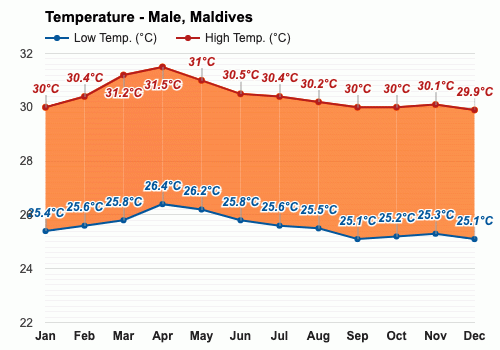
- Average high temperature in February: 30.4°C
The warmest month (with the highest average high temperature) is April (31.5°C).
The month with the lowest average high temperature is December (29.9°C).
- Average low temperature in February: 25.6°C
The month with the highest average low temperature is April (26.4°C).
The coldest months (with the lowest average low temperature) are September and December (25.1°C).
Average humidity in February
Male, Maldives
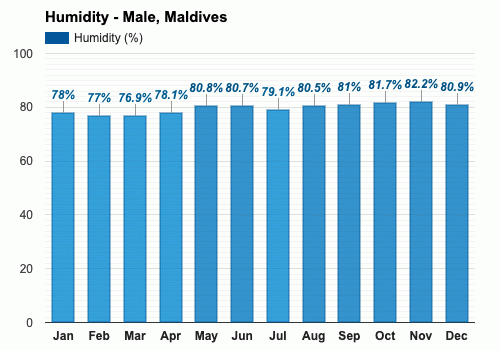
- Average humidity in February: 77%
The month with the highest relative humidity is November (82.2%).
The month with the lowest relative humidity is March (76.9%).
Average rainfall in February
Male, Maldives
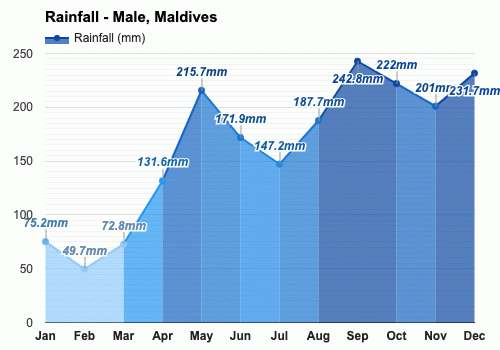
- Average rainfall in February: 49.7mm
The wettest month (with the highest rainfall) is September (242.8mm).
The driest month (with the least rainfall) is February (49.7mm).
Average rainfall days in February
Male, Maldives
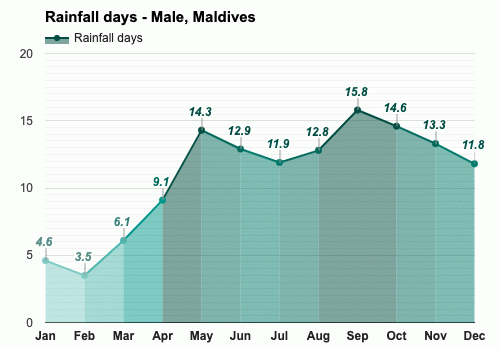
- Average rainfall days in February: 3.5 days
The month with the highest number of rainy days is September (15.8 days).
The month with the least rainy days is February (3.5 days).
Average sea temperature in February
Male, Maldives
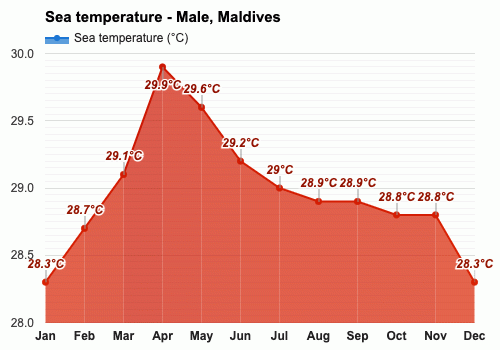
- Average sea temperature in February: 28.7°C
The best month for swimming (with the highest average sea temperature) is April (29.9°C).
The coldest months (with the lowest average sea temperature) are January and December (28.3°C).
Average daylight in February /
Average sunshine in February
Male, Maldives

- Average daylight in February: 12h and 0min
The month with the longest days is June (Average daylight: 12h and 24min).
The month with the shortest days is December (Average daylight: 11h and 54min).
- Average sunshine in February: 9h and 2min
The month with the most sunshine is February (Average sunshine: 9h and 18min).
The months with the least sunshine are June and September (Average sunshine: 6h and 42min).
Average UV index in February
Male, Maldives

- Average UV index in February: 12
The months with the highest UV index are January, February, March, April, May, August, September, October and November (UV index 12).
The months with the lowest UV index are June, July and December (UV index 11).
Male, Maldives
Weather forecast for your location
2. Allow the app to use your location


